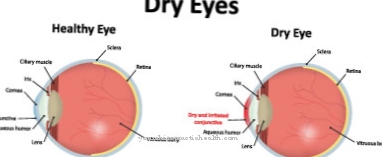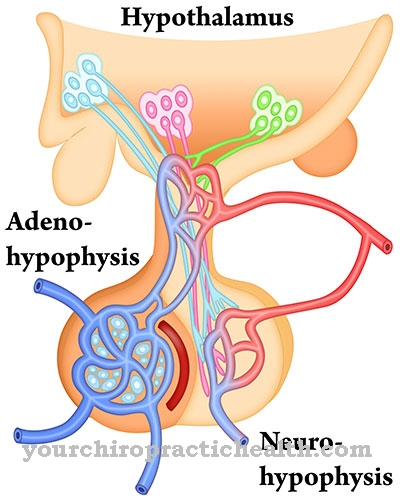Malignant tumors can also form in the eye. Retinoblastoma is one of the most common eye tumors in young children, while adults struggle with the malignant choroidal melanoma tumor. The symptoms and possible therapies depend on the type of cancer. In the early stages, both tumors can be almost completely removed with appropriate treatment - if left untreated, however, they lead to the death of the patient.
What is retinoblastoma?

© Normaals - stock.adobe.com
A retinoblastoma is one of the mutation-related, malignant retinal tumors. Small children (of both sexes) in particular are affected by the malignant tumor. With early detection and treatment, the chances of recovery are around 97 percent.
causes
Almost half of all diseases are hereditary. Usually a damaged allele (expression of a certain gene on a chromosome) is inherited, but these people are heterozygous (mixed-breed) with regard to a mutation of the retinoblastoma gene. If such a gene is damaged, it loses the ability to regenerate, which can lead to uncontrolled growth of retinal cells.
Symptoms, ailments & signs
The symptoms of eye cancer depend on the type, size, and location of the tumor. The tumors often go unnoticed for a long time until the first symptoms appear. Only with so-called retinoblastoma can there be early signs of a disease. A typical symptom here is a whitish glow of the pupil when examining the eye with an ophthalmoscope.
Since retinoblastoma is a congenital hereditary disease, this symptom, known as leukocoria, can occur even in newborns. Sometimes the affected eye is blind at the same time. A so-called strabismus (strabismus) also appears as a frequent symptom.
In rarer cases, red eyes, inflammation in the eye socket, glaucoma, discoloration of the iris or unilateral pupil dilatation can occur. Another malignant eye tumor, the choroidal melanoma, does not initially cause symptoms. It is often discovered by accident. In later stages of the disease, however, there can be significant impairment of visual performance due to retinal detachment.
Furthermore, changes in the birthmark on the choroid can be found during examinations. As with all melanomas, metastases occur in various organs. The corresponding symptoms depend on the organ affected. However, there are no preferred target organs for metastases. Another type of eye cancer, a basalioma on the eyelid, is characterized by speckled nodules that are sometimes crusty and bleeding.
Diagnosis & course
A retinoblastoma is usually diagnosed by a reflection of the fundus (ophthalmoscopy) or with the help of the amaurotic cat's eye. By means of blood analyzes of the affected patient, statements can be made as to whether it is a familial form of a retinoblastoma. If diagnosed early, the chances of recovery are very high and the eyesight should return to its original state. If left untreated, the tumor leads to death.
Complications
The risk of complications in people with eye cancer depends largely on the development of the tumor. The decisive factors here are its size, the affected parts of the eye and the formation of daughter tumors. For this reason, early detection and treatment are important. In most cases, the eye cancer can then be treated successfully without harming the eyesight.
If left untreated, however, the disease leads to death. Complications occur, among other things, when the retinoblastoma grows into the retina. Then various symptoms, such as retinal detachment, can appear, which continue to worsen vision. From a certain level, the doctor decides against the forms of therapy that do not damage the eyesight and in favor of an operation. The entire eye is removed.
In any case, including other forms of therapy, permanent damage to the eye can occur. It becomes particularly dangerous if the tumor develops daughter tumors, so-called metastases. This happens when the cancerous growth grows into the blood vessels of the eye and spreads over the bloodstream there. The liver and bones are most commonly affected in this case. In addition to treating the eye, other therapeutic measures must be taken, such as chemotherapy, which has significantly more aggressive side effects.
Treatment & Therapy
Treatment for retinoblastoma depends on the stage of the disease. Smaller tumors can be treated with radiation therapy. If the retinoblastoma is at an advanced stage, the eyeball must be removed (enucleation). After a successful operation, this is replaced by an eye prosthesis.
prevention
Retinoblastoma disease can hardly be prevented, since the spontaneous mutations cannot be prevented.If there is already a family history of eye cancer, it is advisable that children go to check-ups at regular intervals.
Choroidal melanoma
What is a choroidal melanoma?
The choroidal melanoma is the most common malignant tumor in the eye at 1: 100,000. The black-brown tumor consists of melanin-containing (pigment-containing) cells, which are usually only recognized in advanced stages.
causes
Various studies on the eye have shown that the metastatic disease is primarily related to genetic predispositions. This is the loss of a chromosome 3, also called monosomy 3. Further causes are not yet known - some suspicions point in the direction that UV radiation and a small number of pigments promote the disease in the eye.
Diagnosis & course
A retinal mirror is carried out for the diagnosis, followed by a suspected diagnosis. The height and extent of the tumor is determined by means of an ultrasound examination. Benign changes such as Cysts, can be demarcated with it. In addition, visualization of the blood vessels in the choroid (fluorescence angiography) provides the first indications of a choroidal melanoma.
Often, choroidal melanomas are only detected during routine eye exams. Before this, there are often major changes in the patient's visual performance. This is generally caused by retinal detachment.
Treatment & Therapy
If the tumor is not too large, treatment is carried out with local radiation (brachytherapy). To do this, a radioactive plate is sewn onto the affected eye and left in place for a few days. If the tumor has already passed a certain stage, it is irradiated with protons (teletherapy).
If this treatment does not have any effect or if the choroidal melanoma is already too large, all that remains is the surgical removal of the eyeball (enucleation).
Due to the stable covering of the eye, the so-called dermis (sclera), the chances of recovery from this form of eye cancer are quite high.
Doctors & therapists in your area
Outlook & forecast
If the eye cancer is diagnosed and treated early, the patient has a good chance of recovery. A full recovery is possible if the tumor in the eye is small and the cancer cells have not spread in the organism.
An early removal of the diseased tissue in the eye increases the chances of maintaining normal vision and complete regeneration. Up to 95% of the eye cancer is cured without further complications with an early start of therapy with the current medical possibilities.
If the tumor is at an advanced stage, the chances of complete freedom from symptoms decrease. Eye cancer is often successfully treated and cured at a later stage of the disease, but it can lead to permanent impairment of vision. In particularly severe cases, the diseased eye can go blind without an option for change.
If the diagnosed eye cancer remains untreated for a long time despite severe impairment, the tumor continues to grow. At the same time, the risk of a fatal course of the disease increases. The cancer cells can be transported from their original location to other parts of the organism via the vessels and blood vessels. There they also have the ability to spread. Metastases form and new forms of cancer arise. These significantly reduce the chances of recovery.
You can find your medication here
➔ Medicines for eye infectionsprevention
Prevention of a choroidal melanoma is very difficult, as is the case with retinoblastoma. Eye cancer can mainly be prevented by regular preventive examinations. Due to the good chances of recovery, this is also strongly recommended. In particular, people who have already had such tumors in their families should have regular ophthalmological examinations.
Aftercare
Corresponding follow-up examinations are of great importance in the case of eye cancer. Immediately after the illness has been overcome, regular examinations should take place at short intervals to see whether the cancer may return. The earlier a return of the disease is detected, the better the chances of a full and timely recovery.
However, if the person concerned does not undergo such follow-up examinations, then an unnecessary risk is accepted. This type of cancer can spread throughout the body in no time. An early return of the disease can only be detected and treated accordingly with regular examinations.
These follow-up examinations should be observed even several months or years after the illness has been overcome. Affected people who have survived this form of cancer are always exposed to an increased risk. In order to counteract this risk, an appropriate doctor should be consulted regularly.
Eye cancer can even recur many years after supposed recovery. If you want to avoid this risk, you shouldn't do without appropriate follow-up care. In extreme cases, strictly adhered to aftercare can even save lives. Therefore, this type of investigation should by no means be put off the back burner. The shorter the intervals between the examinations, the lower the risk of a new illness.
You can do that yourself
If eye cancer is suspected, a doctor must first be consulted. The measures the patient can take to promote recovery depends on the type and severity of the cancer.
If the tumor is detected early, a few radiation treatments are often sufficient to completely destroy it. During this time, the patient should take it easy and also comply with the doctor's instructions. Typically, a diet is also followed. Usually there is a decreased appetite, which is why dietary supplements and high-calorie foods must be taken. This and regular hydration ensure that no deficiency symptoms occur during the strenuous radiation therapy.
If visual disturbances or other complications arise, the responsible doctor must be informed immediately. The medication may have to be changed or the therapy may not work. In any case, a close consultation with the doctor is necessary during the treatment so that the therapy can be regularly adjusted to the state of health of the person affected and the stage of the disease.
Cancer often also affects the mental health of the person affected. Therefore, in addition to medical treatment, psychological therapy should also be used. If desired, the therapist can establish contact with other affected persons or refer the patient to a self-help group.
























.jpg)



